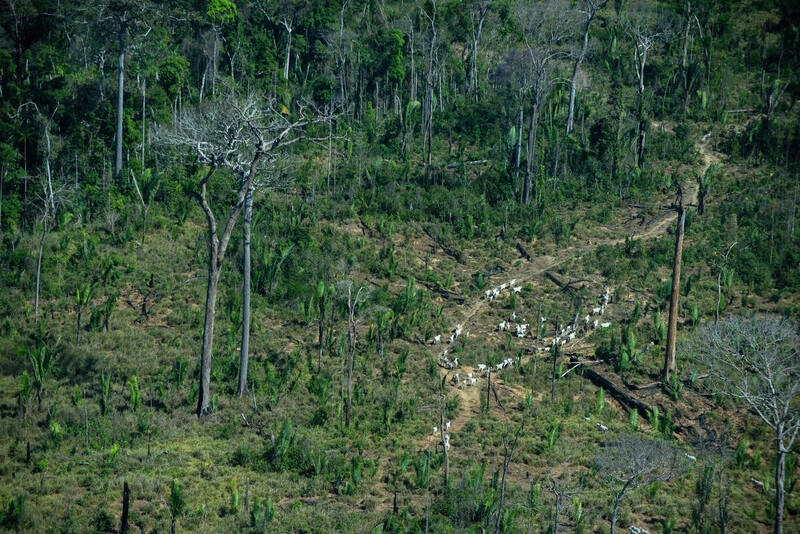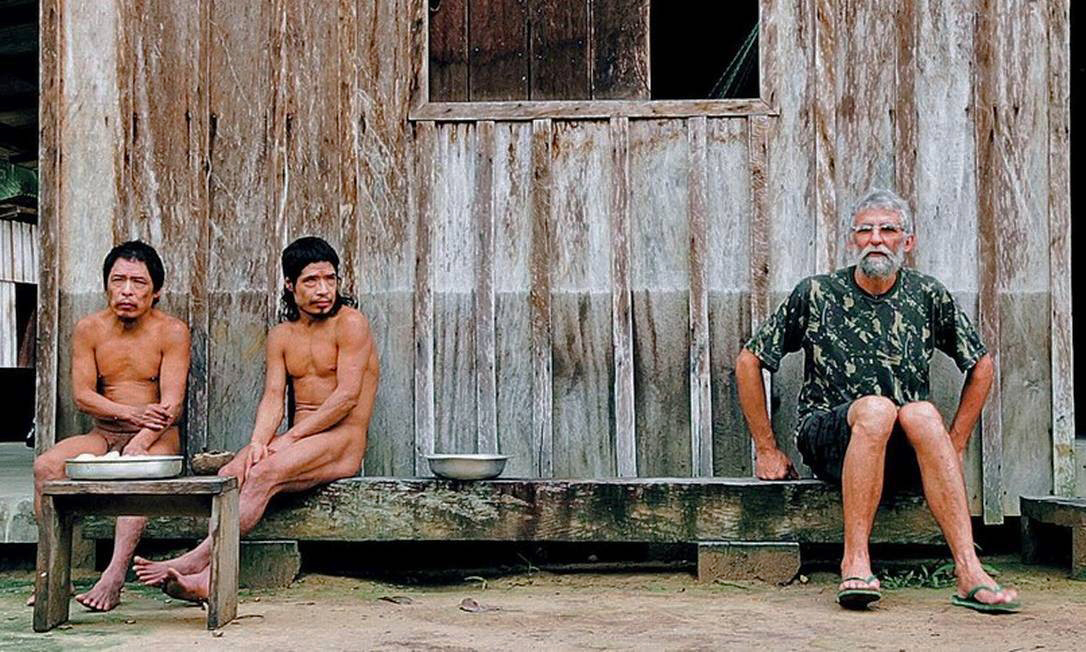- Mining company Oxycer has filed five applications to prospect for gold in the Piripkura Indigenous Territory, in anticipation of restrictions being lifted this October.
- The territory is home to two of the last three surviving Piripkura individuals, who live in voluntary isolation and already face threats from invasions of their territory by illegal loggers and cattle ranchers.
- Mining in Indigenous territories is currently illegal in Brazil, which is why the Federal Public Ministry is pursuing lawsuits to scupper mining requests being filed with the National Mining Agency (ANM).
- However, the ANM continues to accept and register these applications for what’s clearly an illegal activity, though it’s unclear if the agency has approved any of them yet.
A Brazilian company stands poised to start mining inside an Indigenous territory in the Amazon as soon as October, highlighting the precarious nature of the protections afforded to Indigenous lands under the current administration.
Oxycer Mining has filed five applications with the national mining regulator to prospect for gold in the Piripkura Indigenous Territory in Mato Grosso state, according to data from the Instituto Socioambiental (ISA), a nonprofit that advocates for the rights of Indigenous and traditional peoples.
The territory has not yet been demarcated, or officially recognized by presidential decree, and is currently only protected under a legal mechanism known as a “use restriction ordinance.” These ordinances, which protect against activities such as illegal logging and mining, are temporary in nature and must be periodically renewed. The ordinance for the Piripkura territory is due to expire on Oct. 4, according to the ISA, and Oxycer’s mining applications suggest there’s a possibility it won’t be renewed. The Federal Public Ministry is seeking renewal of the ordinance, but the last two ordinances were only renewed for six-month periods, according to the ISA.
The 243,000-hectare (600,500-acre) Piripkura Indigenous Territory is home to one of the world’s most vulnerable uncontacted Indigenous peoples. There are only three known surviving Piripkura individuals: uncle and nephew Pakyî and Tamandua live in voluntary isolation in the Piripkura territory, while Rita, Pakyî’s sister and the only one of the trio with extended contact with the outside world, lives in the Karipuna Indigenous Territory in neighboring Rondônia state. The Piripkura suffered from at least two massacres since their first contact with outsiders in the 1980s and now faces the risk of extinction again.

There’s been an increase in recent years of invasions of the Piripkura territory by outsiders, clearing forest for illegal pastures and logging. At the same time, there’s been little action from Funai, the federal agency for Indigenous affairs, to address the problem — a recurring issue under the administration of President Jair Bolsonaro.
“We need to mobilize and continue to pressure the public authorities and Funai so that the public civil action of the Federal Public Ministry, which asks for the definitive demarcation of the Piripkura, is urgently concluded,” Dinamam Tuxá, executive coordinator for the Brazilian Indigenous Peoples’ Articulation (APIB), told Mongabay by email. “We cannot tolerate another people becoming extinct.”
Pakyî and Tamandua are also at risk from an increasing number of companies securing permits to prospect and mine in areas surrounding the Piripkura territory, according to a report from InfoAmazonia. Deforestation in the territory surged in 2021 compared to recent years, based on data from the ISA; the NGO’s Alerts+ platform also detected that forest fires had scarred 303.5 hectares (816.7 acres) of land in the territory.
Thiago Moreira, a research analyst with the ISA, told Mongabay by email that these threats come amid the Bolsonaro administration’s “dismantling” of protections for Indigenous groups and facilitating of private companies as they anticipate the opportunity to mine on Indigenous lands. This poses a grave risk for tribes like the Piripkura, who, through their voluntary isolation, cannot advocate for themselves against these incursions, Moreira said.
By allowing companies to begin registering interest in exploring these lands, it opens the Indigenous territories up to illegal activities ahead of time, Moreira said. An analysis of publicly available data by the nonprofit news outlet Agência Pública showed a 91% increase in applications to mine inside Indigenous lands in 2019, the first year of the Bolsonaro administration.
Under Brazil’s Constitution, mining is prohibited on Indigenous lands, whether demarcated or not. But the sheer volume of mining applications has given impetus to the government’s efforts to push for wholesale mining and resource extraction on these lands.
“Today, deforestation takes place almost freely within the Piripkura Indigenous Territory. There are active ranches within this area, as shown by surveys carried out by the ISA,” Moreira said.
He added that, on its own, enforcement action by IBAMA, the federal environmental protection agency, would not be enough to stop the invaders. “With the advance of deforestation and the shrinking of the territory, the possibility grows that the remaining Piripkura, highly dependent on the environment in which they live, will not be able to survive,” Moreira said.

On its website, Oxycer explicitly says that it’s begun applying for prospecting permits on Indigenous land in anticipation of legislation supporting mining activity there. The legislation in question is Bill PL 191/2020, championed by the Bolsonaro administration and advocating opening up Indigenous lands to mining and hydroelectric power plants. Congress earlier this year fast-tracked the bill, but it has yet to make its way to the floor of the Chamber of Deputies, the lower house.
But ongoing political developments could scupper the bill. In October, Brazil holds elections in which Bolsonaro is seeking a second term in office. His likely opponent is former president Lula da Silva, whom polls consistently show as the favorite. Lula, for his part, has signaled his opposition to PL 191/2020.
Regardless, Oxycer has outlined an ambitious plan that “will give priority to mining areas in Indigenous lands” while pledging to work with Indigenous groups during the process.
“As for the economic area, Oxycer Mining has a firm policy of sharing all the economic and financial progress from mining on Indigenous lands with the Indigenous peoples, obeying and complying with the precepts of the Law,” the company said on its website, referring to a provision in PL 191/2020 that 50% of mining profits must go to the Indigenous community in the affected area.
Mongabay sought comment from Oxycer about how it plans to prospect for gold in an uncontacted tribe’s territory. The company did not respond.
Representatives from the National Mining Agency (ANM), which handles mining applications, said by email that the agency’s role was solely to “guide our institutional activities in compliance with the laws and regulations contained in the Brazilian legal system.”
When asked to confirm whether it had approved Oxycer’s five applications to mine in the Piripkura territory, in anticipation of the use restriction ordinance not being renewed, ANM did not respond to multiple requests for clarification.
“When we talk about an area with the presence of isolated peoples, such as Piripkura, it is a broad risk,” Moreira said. “The presence of these applications, considered illegal under Brazilian law, may encourage new invasions of this territory.”

‘Legal controversy’
While mining in Indigenous territories, whether demarcated or not, is illegal, applying to carry out this illegal activity falls into a gray area that’s at the heart of the current battle over the integrity of the Piripkura Indigenous Territory.
The Federal Public Ministry (MPF) has sought to use lawsuits to cancel these applications, even if they haven’t been fully approved by the ANM. It says the ANM’s interpretation of the law that allows for these requests to be filed even if there hasn’t been a public consultation process violates both the Brazilian Constitution and Convention 169 of the International Labour Organization (ILO), which Brazil has ratified.
Known as the Indigenous and Tribal Peoples Convention of 1989, it states that Indigenous peoples worldwide have the right to self-determination on their ancestral land and must be afforded “free, prior and informed consultation” whenever there are potential changes in legislation regarding their rights.
In light of this, the MPF has begun filing lawsuits to prevent these mining applications from being filed in Pará state. A representative from the MPF’s office in Mato Grosso was on vacation and unable to confirm whether the ministry was considering similar action against applications to mine on the Piripkura territory.
Since the Piripkura are an Indigenous tribe living in voluntary isolation, any company applying for mining permission should follow the consultative processes outlined in an ordinance by the National Human Rights Council (CNDH) before the ANM even considers any requests, according to a spokesperson for the MPF in Pará. The council determines the need for impact studies assessing a tribe’s isolation and impact on the surrounding land.
The MPF spokesperson told Mongabay in a text message that the issue is a contentious one from a legal standpoint. The MPF considers such applications illegal, while the ANM disagrees. For the MPF, the simple act of acknowledging and registering these applications — before even assessing or approving them — already violates the Brazilian Constitution and Convention 169, which is enshrined in Brazilian law.

FEEDBACK: Use this form to send a message to the author of this post. If you want to post a public comment, you can do that at the bottom of the page.
CORRECTION (9/2/2022): A previous version of this article erroneously attributed a quote to Ariel Bentes, communications officer for the Brazilian Indigenous Peoples’ Articulation (APIB). The quote was actually from Dinamam Tuxá, executive coordinator for APIB. The post has now been corrected.
